So, how did the weekend start? Hopefully an hour earlier than it used to:)
Today is the last day of our attack on tamas, before we move on to rajas guna, which is on the other end of the spectrum. And what better than Surya namaskara, to get rid of that lethargy and laziness that you have accumulated?
The name Surya Namaskar is from the Sanskrit सूर्य Sūrya, “Sun” and नमस्कार Namaskār, “Greeting” or “Salute”.[4] The name identifies the sun as the soul and source of all life.
Surya Namaskar is a sequence of around twelve asanas connected by jumping or stretching movements, varying somewhat between schools. In Iyengar Yoga, the basic sequence is Tadasana, Urdhva Hastasana, Uttanasana, Uttanasana with head up, Adho Mukha Svanasana, Urdhva Mukha Svanasana, Chaturanga Dandasana, and then reversing the sequence to return to Tadasana; other poses can be inserted into the sequence.
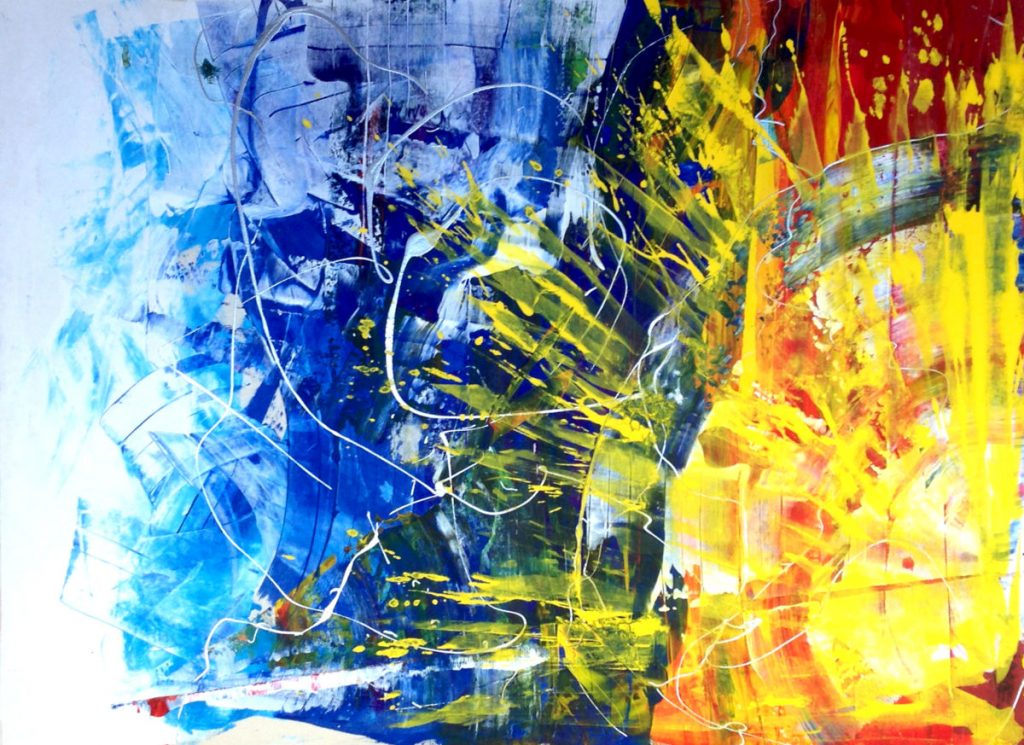
The suryanamaskara is a relatively modern rendering of ancient sun salutations, and also a derivative of Surya Kriya, a way of aligning yourself with the sun and a much more refined process which needs enormous attention in terms of the geometry of the body. It involves a certain level of breath and powerful activation of energy.https://www.youtube.com/embed/HcW_MOXnfKg?feature=oembed
One set of suryanamaskara consists of twelve asanas. One cycle of suryanamaskara comprises two such sets done for the right and left side. You can practice the sequence slowly by staying in each asana for few breaths or you can practice it at a faster pace, breathing in and out as you move from one asana to the other.
Repeating these cycles help you lead an active and healthy life as it regulates and balances the solar energy of the body which flows through pingala nadi. It is performed in a steady rhythmic manner, which also reflects the biorhythms of the body, 24 hours of the day, and the 12 zodiac signs and this rhythmic process helps transform your mind and body completely.
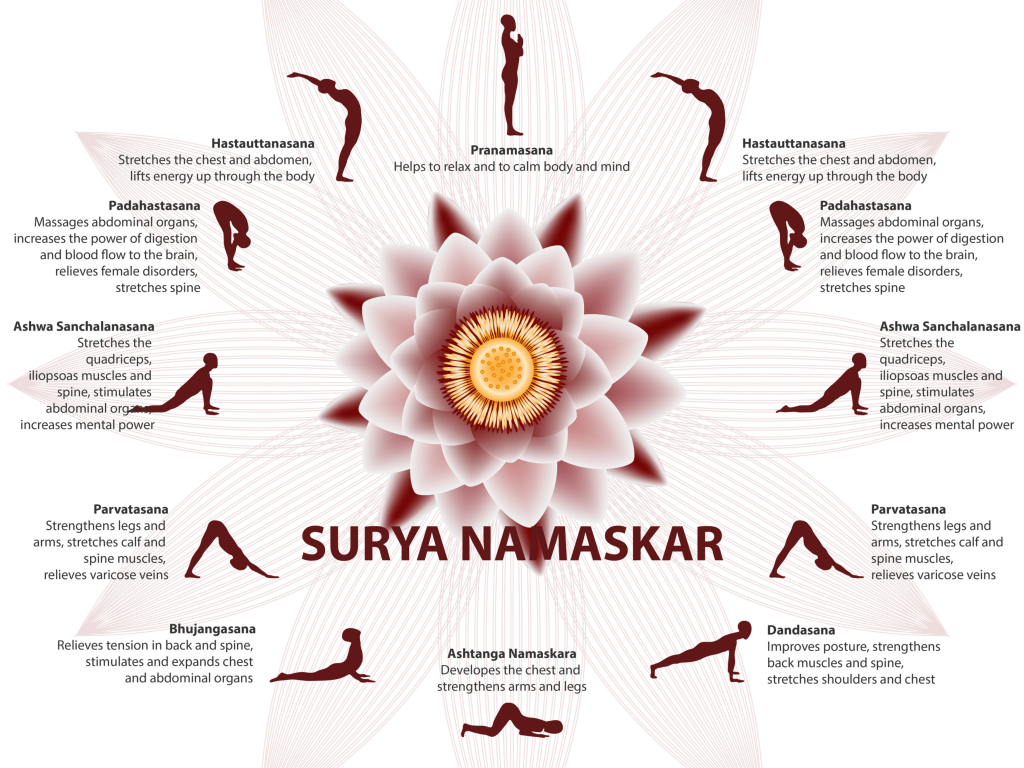
If you are beginner, it is advisable to first practice under an expert’s guidance because finding the right alignment and balance in each asana takes a little time. It is only after you get comfortable with each asana and the flow, can you slowly shift your focus to breathing. It is the combination of rhythmic breath and asana that makes this exercise a powerful detox tool.
The 12 steps of Suryanamaskara
- Pranamasana or Anjali Mudra / Prayer Pose
- Utthana Hasthasana / Upward Salute
- Padahastanasana / Hand To Feet
- Ashva Sanchalanasana / Equestrian Pose
- Phalakasana / Plank Pose
- Ashtanga Namaskra / Salute With Eight Limbs or Knee Chest and Chin
- Bhujangasana / Cobra Pose
- Adho Mukha Svanasana / Downward Facing Dog
- Ashva Sanchalanasana / Equestrian Pose
- Padahastanasana / Hand To Feet
- Utthana Hasthasana / Upward Salute
- Pranamasana or Anjali Mudra / Prayer Pose
1. Pranamasana/ Anjali Mudra
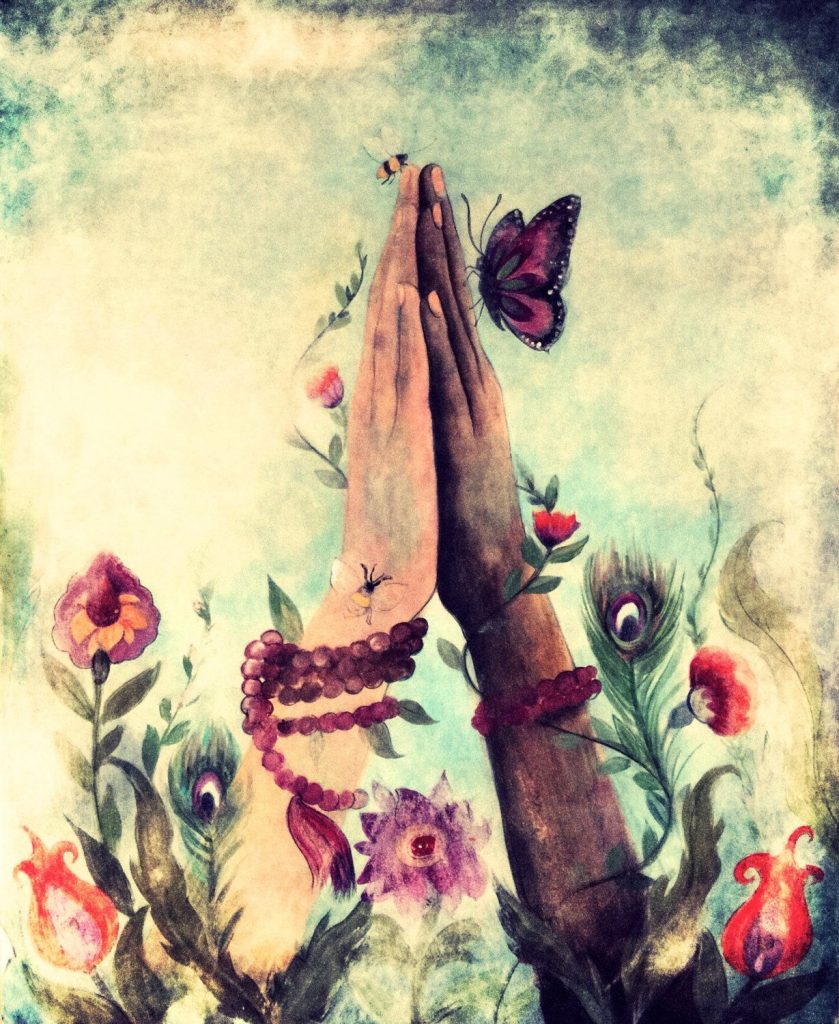
With your feet together or hip width apart, evenly distributing weight on all four corners of your feet, aligning the center of your head to the pelvis, bring your palms together and press them, giving gentle pressure on fingertips and base of your palm. This is essentially Tadasana, with your palms joined in a Namaskara.
Fingers are together and firm with fingertips pointing upward and thumbs slightly touching the heart center / center of the chest.
Relax your neck and shoulders.
This is a simple posture and also the first and last posture in Surya Namaskara.
It helps center the mind and body and helps reduce anxiety and stress.
2. Utthana Hasthasana
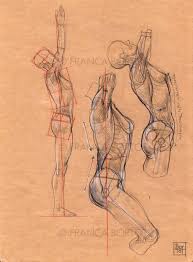
Keeping the palms joined in the previous prayer position, breathe in and lift your arms up and bend backwards slightly. Your biceps should lie close to your ears. This posture is to loosen up your body by stretching the entire body backwards, but keep your feet rooted to the ground.
Hands can be adjusted to stay either in Namaskara mudra or shoulder width apart.
Benefits
Therapeutic for asthma
Reduces symptoms of backache, fatigue and mild anxiety
Stretches the shoulders and armpits
Improves digestion
Caution
Avoid raising your arms if suffering from neck or shoulder injury.
Avoid looking up if feeling dizzy.
3. Padahastanasana
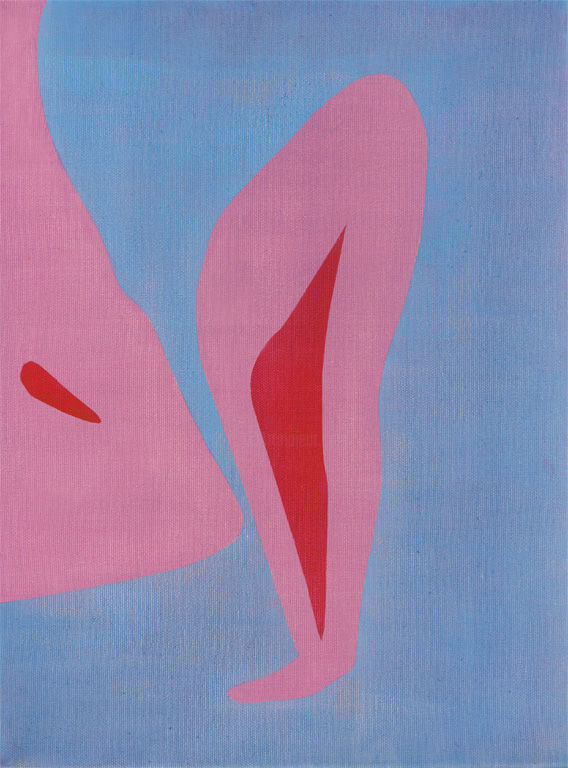
As you exhale, prepare to bend forward by opening your hands wide and dropping them down, next to the feet.
It is okay to keep your knees gently bent.
Keep your neck and shoulder relaxed and see that your spine does not curve.
Press into your heels softly so weight is evenly distributed.
Benefits
Therapeutic for insomnia, osteoporosis
Helps relieve anxiety, stress, headache.
Strengthens thighs and knees
Stretches hips, hamstrings and calves
Helps improve digestion
Helps reduce symptoms of nasal-throat problem
Caution
Lower back pain, neck injuries, high bp, heart problem, ear/eye infection.
4. Ashva Sanchalanasana
From Padahastasana, bend your legs at the knee to place the palms on the mat, in line with your feet.
Breathe in/inhale and take your right leg back to a wide stance. As you do this, your left leg bends at the knee in a 90 degree angle.
The knee and heel of the left leg form a straight line and your right foot is balanced on toes.
Else you can rest your right knee on the mat for support and place right insteps on the floor.
The weight has to be evenly distributed and you should avoid leaning to the front or back.
Benefits
Stretches and strengthens quadriceps and the entire lower body.
Stimulates digestive system and tones kidney and liver.
Builds willpower.
Improves hip flexibility.
Lengthens spine and increases lung capacity,
Caution
Knee and neck injury.
Use modifications such as looking straight and not down and resting back knee on the mat for support.
5. Phalakasana
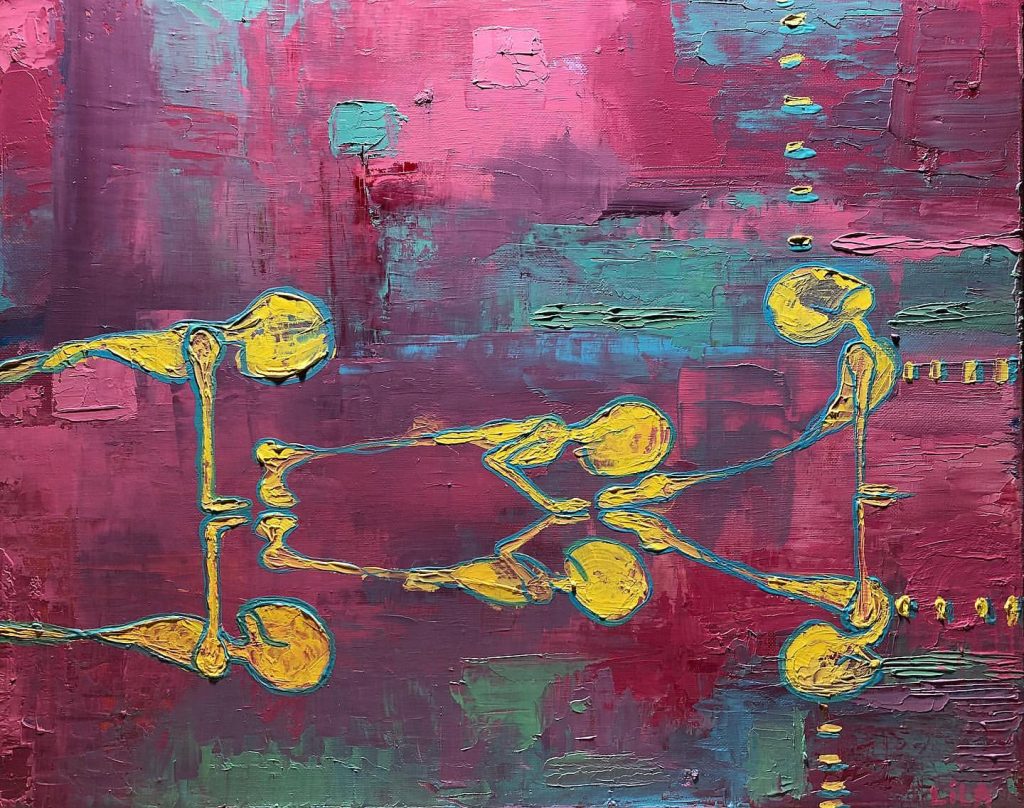
Exhale and step your left leg back to form a plank pose.
See that your shoulders, elbows and wrists are stacked and perpendicular to the floor.
Draw the shoulder blades in towards each other then spread them, widening your collar bones.
Keep the neck relaxed, in line with your spine.
Spread your fingers wide with middle finger facing the front of the mat.
Roll and press your toes into the mat but avoid tightening your knees.
Engage your core and avoid arching by keeping the tailbone tucked in and lengthen it towards the heels.
Benefit
Strengthens arms, wrists and shoulder.
Tones abdomen and builds core strength and endurance.
Caution
Carpal tunnel syndrome, wrist injury or severe low back pain.
6. Ashtanga Namaskra
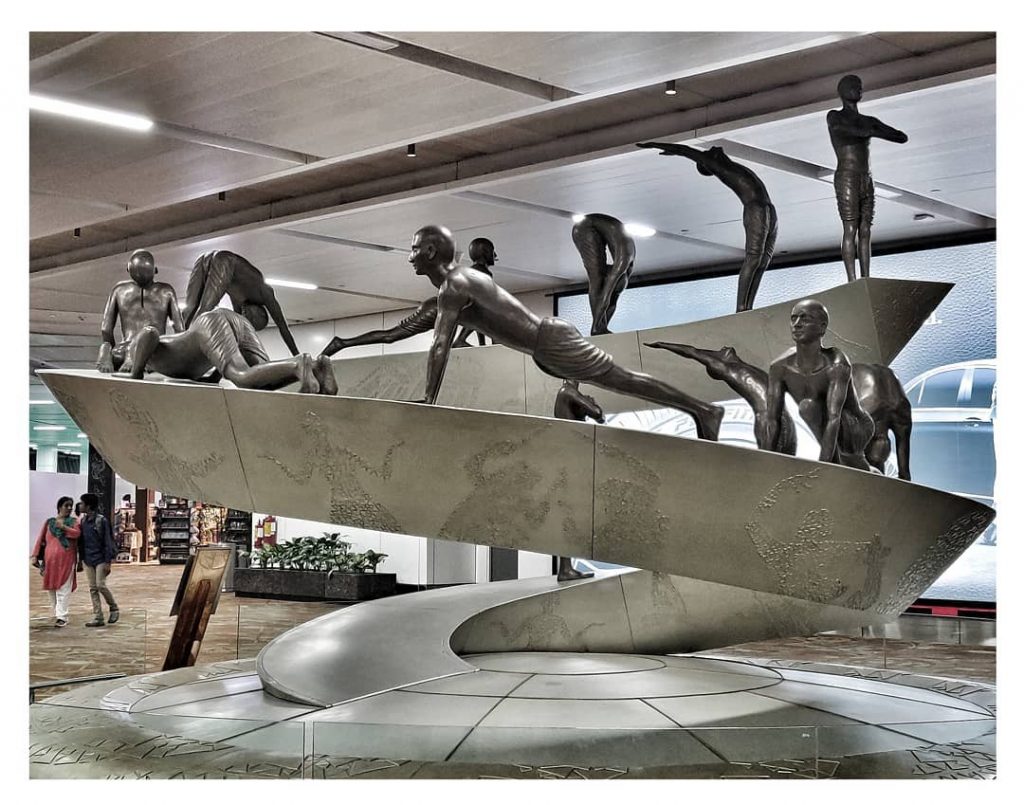
From Phalakasana, drop your chin, chest and knees on the mat at the same time. This is called Ashtanga Namaskara – Ashtanga means eight, and eight limbs touch the floor at the same time, hence the name.
The chest is placed right between the palms.
The elbows are bent, hugging your body and pointing to the ceiling.
The hips stay up/off the mat.
Benefit
Expands the chest and improves flexibility of the back and spine.
Tones and strengthens the arms, shoulders and legs.
Releases tension around neck and shoulder and helps prepare for backbends.
Caution
Spinal or back injuries, buttock pain.
7. Bhujangasana
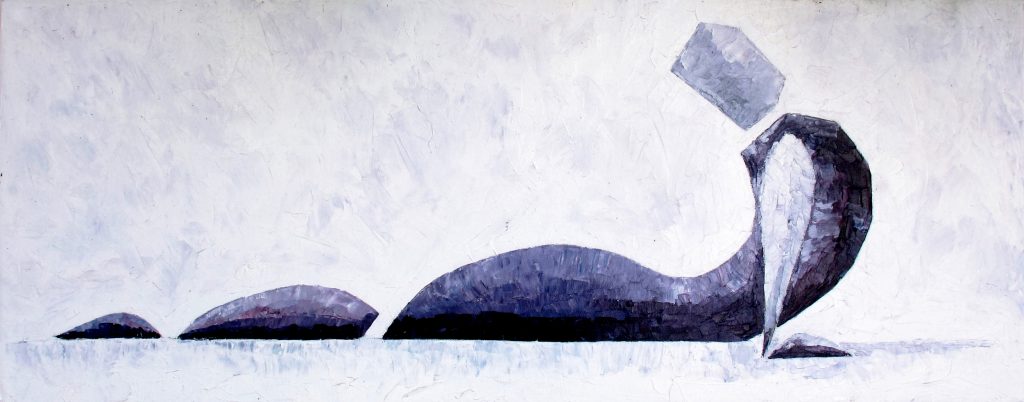
With palms pressed into the mat and elbows gently bent and hugging your body, inhale and lift the chest and head to get into a backbend.
Keep your neck relaxed and roll the shoulders back.
Body below the navel remains pressed down into the mat.
Benefits
Strengthens the entire back and shoulders.
Makes mid and upper back flexible.
Tones abdominal muscles and improves digestive system and blood circulation.
Relieves symptoms of fatigue, menstrual cycle, backache and sciatica.
Therapeutic for asthma.
Expands chest and shoulders.
8. Adho Mukha Svanasana
Exhale and lift the hips up towards the ceiling.
Try and push the heels down towards the mat. Alternatively, you can keep the knees gently bent and heels off the mat.
Slowly drop your head and try and look towards your navel.
The weight should be evenly distributed on hands and feet and neck should be relaxed.
Benefits
Increase height, stretches lower body and strengthens arms, shoulders and back.
Improves blood circulation, calms the nerves and relieves stress
Therapeutic for high bp, asthma, sciatica, sinusitis
Helps relieve symptoms of menopause, back pain and headache.
Caution
Diarrhea, eye or ear infection, wrist injuries.
For high blood pressure or headache – use support for the head.
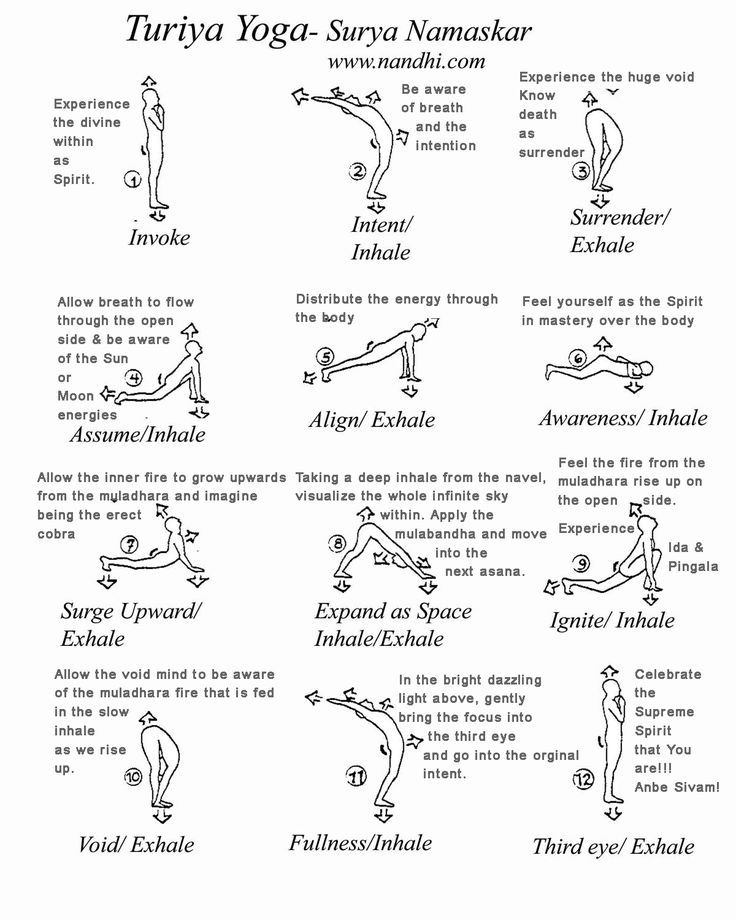
9. Ashva Sanchalanasana
Inhale and bring your right foot forward, in between your palms.
10. Padahastanasana / Utthanasana
Exhale and step your left foot forward in line with your right foot for forward bend.
11. Utthana Hasthasana
Utthana Hasthasana is also the 11th pose in Suryanamaskara.
Steps to follow:
Inhale and lift your body all the way up with your hands stretched in line with your ears.
Push your hips forward and lengthen your spine further by stretching back.
Hands can be adjusted to stay either in Namaskar mudra or shoulder width apart.
12. Pranamasana or Anjali Mudra
Return to Pranamasana. Exhale and bring hands in front of the chest for Namaskar or Anjali mudra. Feet are together or hip width apart, continue to evenly distribute weight on all four corners of your feet.
Align the centre of your head to the pelvis, and give gentle pressure on fingertips and base of your palm.
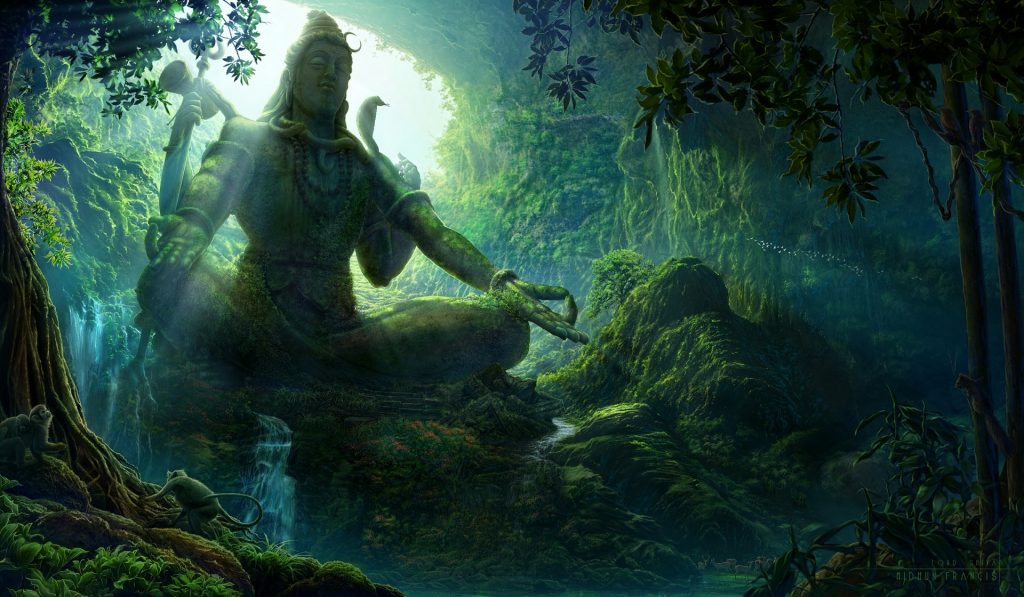
ONE CYCLE IS COMPLETE!
Now repeat the sequence, this time taking your left leg back instead of the right.
How many cycles is good?
You can start with two cycles, go on to four, then eight. Advanced yogis even reach 108 cycles; however, this takes time so don’t rush through it. Doing it correctly is more important than doing it multiple times.
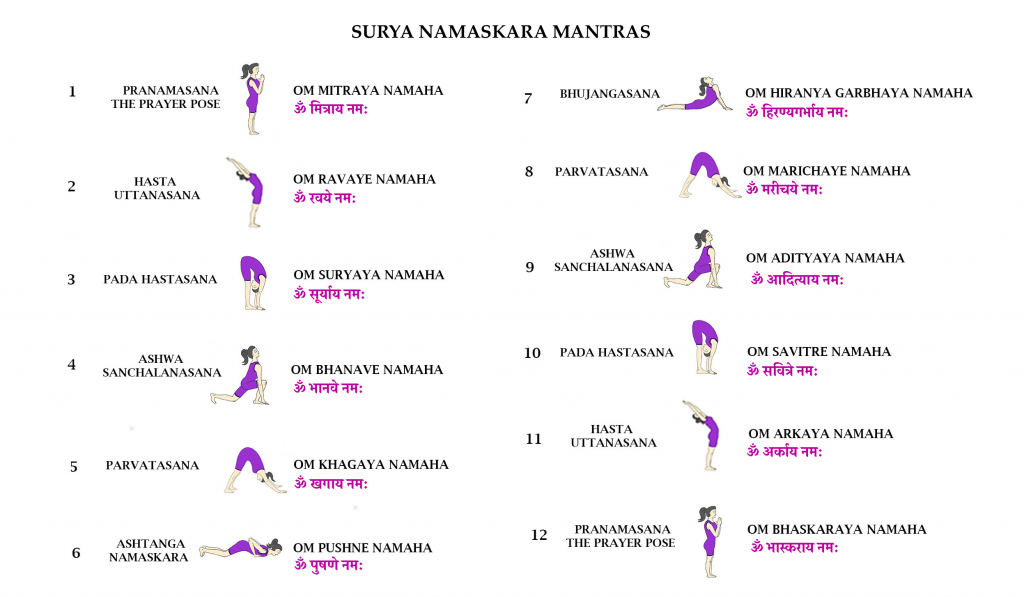
Spirituality
To deepen your practice further and for spiritual benefits, you can include mantra chanting. Surya Mantra has 12 names that are chanted in praise of the Sun and help create harmony between your physical cycles and that of the Sun’s.
By chanting the following 12 names of the Sun you are expressing gratitude and acknowledging the 12 qualities of the Sun. You can dedicate one mantra to each of the 12 steps in the following order. Breathing and chanting in the respective posture helps create more awareness and turns your asana practice into meditation.
Om Mitraya Namaha – A reliable friend to all.
Om Ravaye Namaha – The shining and knowledgeable one.
Om Suryaya Namaha – Guide to all and keeps us active.
Om Bhanave Namaha – Illuminates and bestows beauty.
Om Khagaya Namaha – Stimulator of senses who moves quickly in the sky.
Om Pushne Namaha – Giver of strength who nourishes all.
Om Hiranyagarbhaya Namaha – Creator with the golden womb, the cosmic self.
Om Marichaye Namaha – Lord of dawn and destroyer of diseases.
Om Adityaya Namaha – Son of cosmic mother Aditi who inspires.
Om Savitre Namaha – Lord of creation, the one who purifies.
Om Arkaya Namaha – Worthy of all praises and the radiant.
Om Bhaskaraya Namaha – Illuminates and leads us to enlightenment.
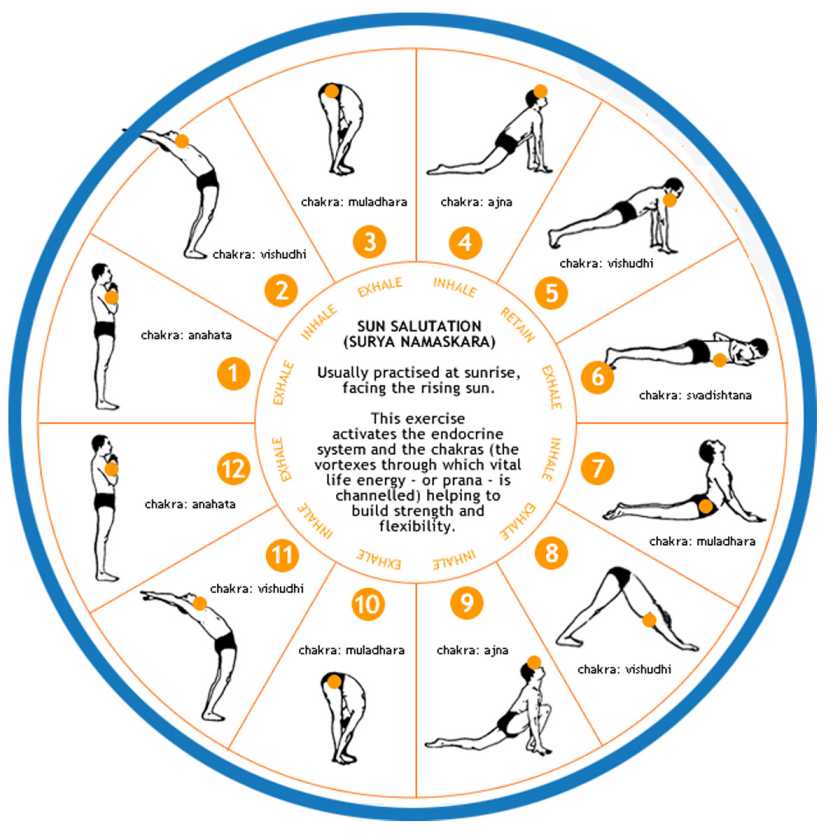
You may find it difficult to chant the 12 names if you are practicing at a fast pace. You can chant 6 bija mantras instead. These seed mantras do not have any literal meaning as such but create powerful vibrations around and within when chanted repeatedly.
In 1 cycle, the 6 mantras are repeated 4 times in the following order:
Om Hraam
Om Hreem
Om Hroom
Om Hraim
Om Hraum
Om Hrah
And so, Sri Vishnu prayed to Devi Mahāmayā, who appeared before him, and said…
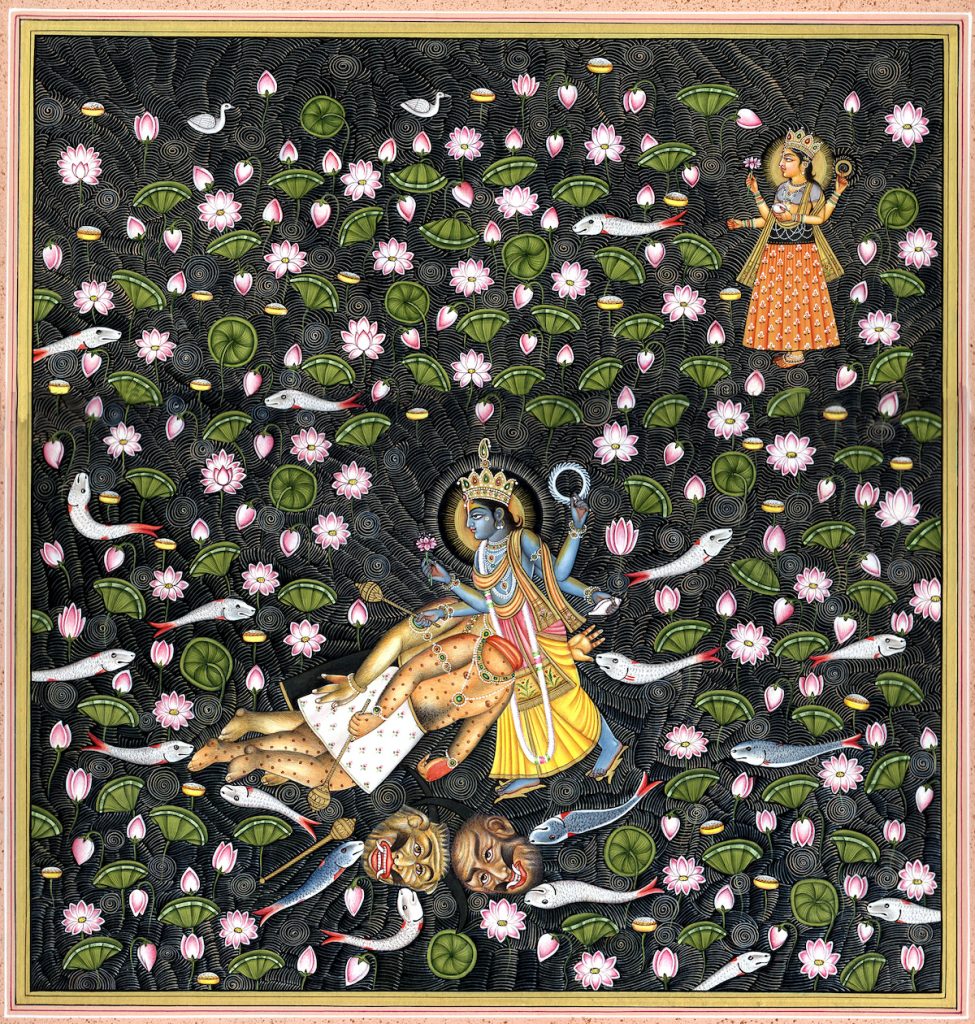
“Sri Vishnu, you have called for me. Tell me what I can do for you.”
“O Devi Mahāmāyā”, said Sri Vishnu with two folded hands, whilst the other two battled the twins, “I have been fighting these asurās for five thousand years, but am no closer to victory than when I started. They have been strengthened by your own boon, and so please show me a way to overcome them.”
“O Sri Narayana, I have heard your prayer. These two asurās have been born of you, and so it is difficult for you to defeat them. Their weakness is their ego, and I will help you to awaken their egos. You will then be able to have your victory.”
Saying this, the Devi turned her gaze to Madhu and Kaitabha, who fell under the spell of Mahāmāyā, and got confounded. While they retained their ability to fight, they lost their ability to reason.
Sri Vishnu observed this, and said “I am impressed by your bravery, O Madhu and Kaitabha. No one has been able to equal me in battle, and that too for such a long time! I am pleased, and I will grant you a boon. Ask me whatever you want, and it shall be yours.”
Still under the influence of Mahāmāyā, Madhu and Kaitabha looked at each other and laughed loudly. “You are losing this battle, Sri Vishnu. You are in no position to grant us a boon. We will be victorious, so instead, let us grant you a boon”, said Madhu, still laughing hard. “Tell us what you want, and it shall be yours”, continued Kaitabha.
“In that case, I accept. I ask for you to reveal to me, how you can be killed”, replied Sri Vishnu.
The twins realized their folly, but it was too late. A boon granted had to be fulfilled. They looked around, all they saw is a vast expanse of water. “We can only be killed where the urvī (earth) is not covered by water, on dry land”, said Madhu.
“Tathastu”, said Sri Vishnu, and transformed into his Vishwaroopa avatar. He then lifted Madhu and Kaitabha onto his ūrvī (thighs) and using his Sudarshana Chakra, beheaded the twins in an instant.
Madhu and Kaitabha are born out of the dirt of Sri Vishnu, a representation of the Mala (which means dirt), the first of the three obstacles to enlightenment. They represent tamas (Madhu) and rajas (Kaitabha), two gunas that trouble the sattva or intellect (Brahma) in our mind (Vishnu). Our intellect realizes that tamas has gripped our mind (Vishnu), but the mind refuses to listen. It needs the intervention of a higher force to awaken and fight the tendencies that make us lazy, or constantly disturbed.
The twins realized their mistake but a boon given had to be fulfilled. They looked around and saw only water [rasa, pleasure] everywhere and thus mentioned to Sri Vishnu that they could be killed only on dry land [dryness, penance, austerity, tapas]. One can get rid of tamas and rajas, but it takes self-control, and the use of the intellect.
Madhu also means honey, or nectar, and Kaitabha means an insect, which can be thought of as a honey-bee. If you want the sweet honey of life, you have to also be prepared of the sting of the bee. Madhu is also tāmsic, as is any sweet that is more in quantity. A bee is always rājsic (as busy as a bee).
The lowest category of opposition is of the nature of dirt, Mala; and psychologically, from the point of view of the seeking soul, this dirt is in the form of Kama, Krodha and Lobha. “Kama esha krodha esha rajo-guna samudbhavah”, “Kamah krodhastatha lobhah tasmat etat trayam tyajet”: It is desire and anger born of Rajas; desire, anger and greed – these three therefore should be abandoned, says the Bhagavadgita.
Swami Krishnananda
Devi also mentions to Vishnu (mind), that Madhu and Kaitabha are born of him…they are reflections of his own and hence it is difficult to defeat them. You can fight the enemy outside you, but the enemy within is much stronger than them. And it takes a lot of sādhanā to achieve this.
The wise have told us that Mala or dirt of the psychological structure can be removed by Karma Yoga, by unselfish and dedicated service.
But when you get rid of kāma, krodha and lobhā, that is just the first step. A celebration is not in order. There are more challenges on the way – challenges that will involve the Devi fighting with Mahishasura and Raktabija. How does she win? What is the inner meaning? Keep reading to find out!
ॐ देवी कूष्माण्डायै नमः॥
Om Devi Kushmandayai Namah॥
या देवी सर्वभूतेषु माँ कूष्माण्डा रूपेण संस्थिता। नमस्तस्यै नमस्तस्यै नमस्तस्यै नमो नमः॥
Ya Devi Sarvabhuteshu Maa Kushmanda Rupena Samsthita।
Namastasyai Namastasyai Namastasyai Namo Namah॥
